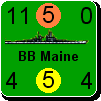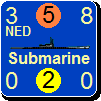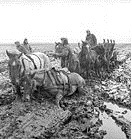Rasputitsa
Posts: 2903
Joined: 6/30/2001
From: Bedfordshire UK
Status: offline

|
However impressive the 'Bismarck' may have looked, she was built using some of the design concepts from WW1 as these plans were brought out to speed the building process. The main armoured deck was set quite low, which ensured that the lower decks were protected, especially from the close range flat trajectory shots 'KG5' and 'Rodney' were delivering near the end of the battle, but it did mean that some communication and electrical systems were not adequately protected. The upper decks could be pulverised, whilst lower decks and flotation were better protected.
In common with German practice in both world wars, major vessels (with the exception of the 'pocket battleships', with a commerce raiding capability) were designed for specific missions, rather than worldwide naval service. RN ships were designed for long cruising in conditions from the Artic to the Tropics, with consequently large crew spaces. German ships, with crews mainly based ashore, until a mission was launched, could have greater sub-division into smaller internal spaces, greatly improving flotation after damage.
German warship design showed an amazing ability to absorb considerable damage and remain afloat, as demonstrated by 'Seydlitz' after Jutland, but this is of little value in the open ocean, where help is not near at hand.
'Bismarck' was no super ship and suffered from all the vulnerabilities which afflicted battleships in WW2 (as with 'Prince of Wales' and 'Yamato'), the main point being that she was quickly disabled and unable to effectively fight back.
Sinking, or not, a ship unable to function is 40,000 tons of scrap iron.
< Message edited by Rasputitsa -- 3/10/2012 2:49:54 PM >
_____________________________
"In politics stupidity is not a handicap" - Napoleon
“A people which is able to say everything becomes able to do everything” - Napoleon
“Among those who dislike oppression are many who like to oppress" - Napoleon
|
 Printable Version
Printable Version


 Anyway. I am grateful for all the information you have provided but lets close this subject for now and lets focus on our favorite game.
Anyway. I am grateful for all the information you have provided but lets close this subject for now and lets focus on our favorite game. 




















 New Messages
New Messages No New Messages
No New Messages Hot Topic w/ New Messages
Hot Topic w/ New Messages Hot Topic w/o New Messages
Hot Topic w/o New Messages Locked w/ New Messages
Locked w/ New Messages Locked w/o New Messages
Locked w/o New Messages Post New Thread
Post New Thread